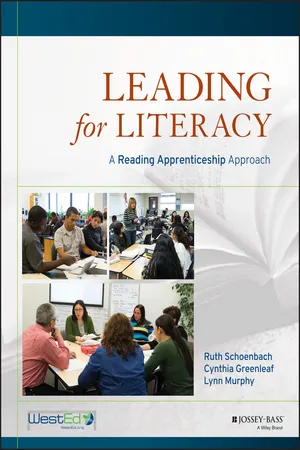
Leading for Literacy
A Reading Apprenticeship Approach
- English
- ePUB (mobile friendly)
- Available on iOS & Android
About This Book
Clear, on-the-ground guidance for Reading Apprenticeship implementation
Leading for Literacy provides tools and real-life examples to expand the benefits of a literacy approach that sparks students' engaged reading and thinking across disciplines, from middle school through community college. A companion to the landmark Reading for Understanding, this book guides teachers, leaders, and administrators through the nuts, bolts, benefits, and stumbling blocks of creating Reading Apprenticeship communities that extend a culture of literacy beyond individual classrooms.
This book explains how to generate authentic buy-in from teachers and administrators, use the Reading Apprenticeship Framework to turn reform overload into reform coherence, and create literacy teams, professional learning communities, and Reading Apprenticeship communities of practice that sustain an institutional focus on a student-centered, strengths-based culture of literacy.
Key insights from Reading Apprenticeship practitioners across the country address how to get started, build momentum, assess progress, and build partnerships and networks across schools, districts, campuses, and regions.
Persistently low levels of adolescent literacy continue to short-change students, contribute to discredited high school diplomas, and cause millions of students to drop out of high school and community college. Forty percent or more of community college students require remedial reading courses as college freshman. The researchers at WestEd's Strategic Literacy Initiative developed the Reading Apprenticeship Framework to provide educators with a proven path to improving literacy for all students, and this book provides clear guidance on bringing the framework to life.
- How to integrate Reading Apprenticeship with existing reform efforts
- How to use formative assessment to promote teacher and student growth
- How to coach and empower teachers
- How to cultivate literacy leadership
- How to provide long-term support for a strong content-literacy program
Nationwide classroom testing has shown Reading Apprenticeship to promote not only literacy and content knowledge, but also motivation and positive academic identity—leading to better student outcomes that reach beyond the classroom walls. Leading for Literacy lays out compelling ways to spread the benefits of Reading Apprenticeship, with practical guidance and real-world insight.
Frequently asked questions
Information
Chapter One
How to Start?
We want reading to be woven into the fabric of what is happening on our campus, to put reading into every conversation about student success, whether it is equity, first‐year experience, basic skills, even accreditation—and to connect those conversations and initiatives.—Chris Padgett, American River College history instructor
Taking Up Transformational Change
Reading Apprenticeship makes a difference in the way people teach and the way kids learn, but it's not something you can say, “We're doing this tomorrow,” and have it be done tomorrow. It takes time and energy, and some patience and commitment from all parties involved.—Randy Gawel, Berkley High School principal
- How can teachers, convinced from their own experience of the effectiveness of Reading Apprenticeship, create opportunities for genuine buy‐in from other teachers and administrators?
- Are there ways administrators can initiate classroom change without the well‐known pitfalls of top‐down implementation?
- How can leadership teams turn external mandates into positive steps to meet their own goals for change?
- How can schools incorporate Reading Apprenticeship without adding to reform overload?
Leading Change at the Middle and High School Level
Reading Apprenticeship can't be seen as an extra program, it can't be seen as a one‐off. It has to be embedded into professional development and revisited.—Janet Rummel, Chief Academic Officer for Goodwill Education Initiatives, Excel Centers2
Building Excitement from Teacher to Teacher
Table of contents
- Cover
- Table of Contents
- Copyright Page
- List of Close-Ups
- List of Team-Tools
- Foreword
- Preface
- Chapter 1: How to Start?
- Chapter 2: Partnering for Leadership
- Chapter 3: The Role of Inquiry in Reading Apprenticeship Professional Learning
- Chapter 4: Setting the Social and Personal Foundations for Inquiry
- Chapter 5: Exploring Reading as Colleagues
- Chapter 6: Exploring Instruction as Colleagues
- Chapter 7: Building Capacity, Momentum, and Sustainability
- Appendix A: Reading Apprenticeship Framework
- Appendix B: The Research Rationale for Inquiry‐Based Teacher Professional Development
- Appendix C: Assessment Tools
- Index
- End User License Agreement